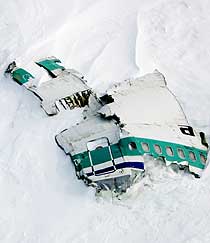Controlled flight into terrain facts for kids

A controlled flight into terrain (CFIT, pronounced cee-fit) happens when a perfectly good airplane, under the pilot's control, accidentally flies into the ground, a mountain, a body of water, or another obstacle. In these accidents, the pilots usually don't realize they are in danger until it's too late. Engineers at Boeing came up with the term "CFIT" in the late 1970s.
Accidents where the plane is out of control due to mechanical problems or pilot mistakes are not called CFIT. Also, accidents caused on purpose, like acts of terrorism, are not CFITs.
According to Boeing, CFIT is a major reason for airplane accidents where people lose their lives. It has caused over 9,000 deaths since commercial jet flights began.
Contents
Why CFIT Accidents Happen
Many things can cause a plane to crash into the ground. These include bad weather or problems with navigation equipment. However, mistakes made by the pilots are the most common reason for CFIT accidents.
The biggest pilot mistake in CFIT accidents is when pilots don't always know exactly where their plane is. They might not know how close they are to the ground or mountains ahead of them. This is called a "loss of situational awareness." Even very experienced pilots can make big mistakes if they are tired. These errors can then lead to a CFIT accident.
CFIT accidents often happen when planes hit hills or mountains in bad weather. This is especially true when planes are trying to land at an airport. Sometimes, small problems with navigation equipment can also play a part. If pilots don't notice these issues, the equipment might guide the plane incorrectly.
How to Prevent CFIT Accidents
Before electronic warning systems were invented, the only ways to prevent CFIT were pilot training in simulators. Pilots also followed strict procedures, used CRM (which helps the crew work together), and air traffic services watched planes on radar. These methods helped reduce CFIT accidents, but they didn't stop them completely.
To further prevent CFIT accidents, airplane makers created special systems. These are called terrain awareness and warning systems (TAWS).
The first version of these systems was the ground proximity warning system (GPWS). It used a radar altimeter to figure out how fast the plane was getting close to the ground. This system was later improved by adding a GPS map of the terrain. This newer system is known as an enhanced ground proximity warning system (EGPWS). When pilots are trained to react correctly to any warnings from this system, it has been very successful in preventing CFIT accidents.
Smaller planes often use a GPS map of the ground to warn pilots. This GPS map shows nearby terrain in red or yellow. The color depends on how close the plane is to the ground.
Statistics show that planes with the improved EGPWS have almost no CFIT accidents if the system is used correctly. There have been a few cases where the system was turned off by the pilot, leading to a crash. For example, in the Mount Salak Sukhoi Superjet 100 crash, the TAWS was working, but the pilot turned it off on purpose.
Notable CFIT Accidents
Many famous accidents have been caused by controlled flight into terrain. Here are a few examples:
- TWA Flight 3 (January 16, 1942): The plane hit a cliff in Nevada shortly after takeoff. The crew flew off their safe path at night.
- BSAA Star Dust (August 2, 1947): The crew thought they were close to the airport in Chile. But they were actually still over a mountain in the Andes. The plane disappeared and its wreckage was found 50 years later.
- United Airlines Flight 409 (October 6, 1955): The plane crashed into Medicine Bow Peak in Colorado. It went off its planned flight path for an unknown reason.
- Eastern Air Lines Flight 401 (December 29, 1972): The pilots became too focused on a broken landing gear light. They didn't notice the plane was slowly losing altitude. The plane, which was otherwise fine, crashed into a swamp. This accident became the subject of books and movies.
- Air New Zealand Flight 901 (November 28, 1979): This plane crashed into Mount Erebus in Antarctica. The plane's pre-programmed path was changed without telling the pilots. The pilots also lost track of their position and there was a "whiteout" (where everything looks white) at the time.
- Avianca Flight 011 (November 27, 1983): Pilot and navigation errors caused the plane to descend too early into hilly terrain.
- American Airlines Flight 965 (December 20, 1995): The plane crashed into a mountain in Colombia. The crew made several navigation mistakes and forgot they had deployed the air brakes.
- Korean Air Flight 801 (August 6, 1997): A Boeing 747 crashed into Nimitz Hill on approach to Guam. The tired crew used old flight maps.
- Mount Salak Sukhoi Superjet 100 crash (May 9, 2012): This plane crashed during a demonstration flight. The pilots had turned off the terrain warning system on purpose. They were talking to potential customers when the crash happened.
Images for kids
See also
 In Spanish: Vuelo controlado contra el terreno para niños
In Spanish: Vuelo controlado contra el terreno para niños


